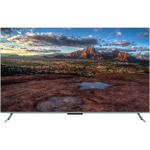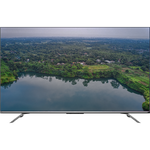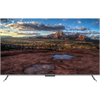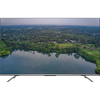A comparison of specs, key information, reviews, and best pricing from top retailers
Last updated -- hours ago | Report incorrect information
What we think

The PerfectRec TV team Learn more
Updated January 10, 2024·
If you're into gaming, the Hisense U7G offers a better experience with a higher refresh rate and better motion handling, which is advantages for fast-paced games or sports. On the other hand, the Amazon Omni QLED may offer a superior streaming experience for movies and TV shows with its better color accuracy and out-of-the-box picture settings. When it comes to bright room usage, both have sufficient peak brightness, but if you are concerned with reflection handling, the Hisense could perform better. Both TVs offer a good set of smart features, but the Amazon TV integrates tightly with Alexa for potentially better smart home integration. Give Feedback
this description is based on the product variant with some specs and product variant with some specs. At the time of writing, the variant with some specs cost some dollars and the variant with some specs cost some dollars.
Advantages of the Amazon Omni QLED (LCD)
- Very good for cartoons & animation
Advantages of the Hisense U7G (LCD)
- Good for bright room
- Very good for gaming
- Very good for news, talk, & other TV
- Good for use as monitor
- Good for upscaling
Key differences
Gaming
6.4


8.0
6.1/10
RESPONSE TIME SCORE
7.0/10
8.0/10
INPUT LAG SCORE
7.6/10
3.2/10
MOTION PROCESSING
3.2/10
75.0/100
GAMING LOCAL DIMMING
70.0/100
6.5/10
GAME HDR BRIGHTNESS SCORE
8.2/10
The Hisense U7G (LCD) is very good for gaming, while the Amazon Omni QLED (LCD) is only fair.
The Hisense U7G is better suited for gaming because it has a higher refresh rate, allowing for smoother visuals in fast-paced games, and overall it delivers faster response times and lower input lag, which are critical for quick and responsive gameplay. In contrast, while the Amazon Omni QLED offers good input lag, it falls short with a lower refresh rate and fair response time, which could lead to less fluid motion and delayed reactions in gaming scenarios.
Cartoons & Animation
8.3


7.7
8.0/10
COLOR GAMUT SCORE
7.7/10
8.2/10
COLOR VOLUME SCORE
7.2/10
7.6/10
SDR BRIGHTNESS SCORE
8.8/10
7.6/10
COLORS OUT OF THE BOX SCORE
6.4/10
7.0/10
GRAY UNIFORMITY
7.0/10
The Amazon Omni QLED (LCD) is very good for cartoons & animation, while the Hisense U7G (LCD) is good.
The Amazon Omni QLED delivers more vibrant colors out of the box and a wider color gamut, ensuring cartoons and animations look more vivid and closer to the creator's intent, which is very beneficial for that genre. The Hisense U7G also provides good color accuracy and gamut, but with slightly less vibrancy in comparison to the Amazon Omni QLED, however, it offers better brightness for standard dynamic range content which is somewhat important when watching animations.
Bright Room
6.9


7.7
5.3/10
VIEWING ANGLE
5.5/10
7.6/10
SDR BRIGHTNESS SCORE
8.8/10
6.3/10
HDR BRIGHTNESS SCORE
7.7/10
6.0/10
REFLECTIONS SCORE
6.3/10
The Hisense U7G (LCD) is good for bright room, while the Amazon Omni QLED (LCD) is only fair.
Cost
$600


$698
$200
$400
$600
$800
$1,000
$1,200
The Amazon Omni QLED (LCD) has a price of $600 and the Hisense U7G (LCD) costs $698.

Let Us Help Find Your Perfect TV
Find your new TV
Key similarities
Picture Quality
7.7


7.6
9.07/10
CONTRAST
7.75/10
8.2/10
COLOR VOLUME SCORE
7.2/10
LED FALD
PANEL TYPE
LED FALD
VA
PANEL SUB-TYPE
VA
The Amazon Omni QLED (LCD) and Hisense U7G (LCD) both have good picture quality.
Movies & TV
7.8


7.4
9.07/10
CONTRAST
7.75/10
6.5/10
BLACK UNIFORMITY
6.4/10
6.6/10
UPSCALING
7.5/10
Yes
HDR10 SUPPORT
Yes
Yes
HDR10+ SUPPORT
Yes
Yes
DOLBY VISION SUPPORT
Yes
The Amazon Omni QLED (LCD) and Hisense U7G (LCD) are both good for movies & TV.
The Amazon Omni QLED excels in contrast and black uniformity, integral for deep blacks in movies, while its local dimming feature lends a hand in enhancing these scenes further. On the other hand, the Hisense U7G also provides good contrast and local dimming, plus it offers better color accuracy straight out of the box, making it another strong choice for movie enthusiasts.
Sports
6.0


6.1
3.2/10
MOTION PROCESSING
3.2/10
60Hz
REFRESH RATE
120Hz
8.0/10
INPUT LAG SCORE
7.6/10
6.6/10
UPSCALING
7.5/10
7.6/10
SDR BRIGHTNESS SCORE
8.8/10
Yes
HLG SUPPORT
Yes
The Hisense U7G (LCD) and Amazon Omni QLED (LCD) are both only fair for sports.
The Amazon Omni QLED and Hisense U7G both have challenges with sports viewing due to fair response times and motion processing, which are crucial for smooth action. Additionally, they have fair reflections handling that could be problematic in bright rooms, and their viewing angles are not wide, which can diminish the viewing experience from side seats; however, their gray uniformity is decent, helping with the look of playing fields.
News, Talk, & Other TV
7.7


8.1
7.6/10
SDR BRIGHTNESS SCORE
8.8/10
6.6/10
UPSCALING
7.5/10
Although they have very similar scores, PerfectRec considers Hisense U7G (LCD) to be very good for news, talk, & other TV, while the Amazon Omni QLED (LCD) is good.
The Amazon Omni QLED's good SDR brightness and very good color performance out of the box make it suitable for viewing news and TV programs, though it may not be as bright as some alternatives. In comparison, the Hisense U7G boasts very good SDR brightness, ensuring clear visibility in various lighting conditions, and has better upscaling, which helps when watching lower resolution content, though its colors out of the box are not as accurate as the Amazon Omni QLED.
Give feedback
We’re constantly working to improve.
How the Amazon Omni QLED (LCD) and the Hisense U7G (LCD) compare to other TVs
Spec Comparison
| Amazon Omni QLED (LCD) | Hisense U7G (LCD) |
GENERAL | |||
|---|---|---|---|
| Price | |||
$600 | $698 | ||
Brand | |||
Brand | Amazon | Hisense | |
Release Date | |||
Release Date | September 1, 2022 | June 2, 2021 | |
Full name | |||
Full name | QL65F601 | 65U7G | |
Screen Size | |||
Screen Size | 65" | 65" | |
Screen Resolution | |||
Screen Resolution | 4K | 4K | |
TV FEATURES | |||
|---|---|---|---|
Operating System | |||
Operating System | Fire OS | Android TV | |
Sound Quality Score | |||
Sound Quality Score | 9.2/10 | 7/10 | |
NextGen Ready | |||
NextGen Ready | No | No | |
HDMI Ports | |||
HDMI Ports | 4 | 4 | |
Coax Ports | |||
Coax Ports | 1 | 1 | |
DISPLAY QUALITY SCORES | |||
|---|---|---|---|
Picture Quality Score | |||
Picture Quality Score | 7.8/10 | 7.7/10 | |
Bright Room Score | |||
Bright Room Score | 6.9/10 | 7.8/10 | |
Gaming Score | |||
Gaming Score | 6.4/10 | 8/10 | |
Movies & TV Score | |||
Movies & TV Score | 7.8/10 | 7.4/10 | |
Sports Score | |||
Sports Score | 6.1/10 | 6.2/10 | |
PHYSICAL | |||
|---|---|---|---|
Dimensions w/o Stand (H x W x D) | |||
Dimensions w/o Stand (H x W x D) | 33.4" x 57.1" x 3.2" | 33.1" x 57" x 3.5" | |
Dimensions with Stand (H x W) | |||
Dimensions with Stand (H x W) | Unknown" x Unknown" | 35.5" x 57" | |
Weight without Stand | |||
Weight without Stand | 45.4 lbs | 43.0 lbs | |
VESA Mount | |||
VESA Mount | 400 x 300 | 300 x 200 | |
DISPLAY | |||
|---|---|---|---|
Color Depth | |||
Color Depth | 10 bit | 10 bit | |
Black Frame Insertion | |||
Black Frame Insertion | Yes | Yes | |
Auto Low Latency Mode | |||
Auto Low Latency Mode | Yes | Yes | |
Contrast | |||
Contrast | 9.1/10 | 7.8/10 | |
Local Dimming | |||
Local Dimming | 6.3/10 | 6.5/10 | |
SOUND | |||
|---|---|---|---|
Speaker Setup | |||
Speaker Setup | 2.0 | 2.0 | |
Speaker Power | |||
Speaker Power | 24 W | 20 W | |
Dolby Atmos | |||
Dolby Atmos | Yes | Yes | |
DTS:X | |||
DTS:X | No | Yes, Bypass only | |
Shopping
Amazon Omni QLED (LCD)
See more
Dig into reviews and images
Tech Advisor
Jim Martin | April 2023
"This really is a TV designed for the streaming generation ... And it’s good to see support for both HDR10+ and Dolby Vision because it means more of the content you stream will be available in HDR. Overall, the Omni QLED is an impressive TV. It’s pretty bright, has good contrast and – thanks to those quantum dots – vibrant colours."
Get a great deal on the Amazon Omni QLED (LCD) or the Hisense U7G (LCD)
About Amazon
Amazon, the largest online retailer in North America, has forged partnerships with TCL and Hisense to produce white-label TVs incorporating their Fire OS software. These Amazon-branded TVs typically compete in the low-end and mid-range segments, offering compelling price points. Leveraging their strong reputation, Amazon has swiftly built brand trust in the TV market despite being relatively new to it. To enhance their popularity, these TVs integrate features from the Amazon ecosystem, including Alexa, providing users with a seamless and interconnected TV experience.
About Hisense
Hisense, a Chinese TV manufacturer, entered the US market in approximately 2011 and has since acquired TV divisions from various companies such as Toshiba, Sharp, Hitachi, and NEC. Currently ranking as the fourth largest vendor in terms of sales volume, Hisense aims to capture a wide range of TV budget segments. They offer exceptional value with TVs that often outperform their competitors at similar price points, making them a compelling choice for consumers. In the US, they use Google TV as their smart TV software which provides the largest app selection and a very modern user interface, however it is not as user friendly as the software from other vendors.
Give feedback
We're constantly perfecting our model
TV guides you might be interested in
More comparisons for you
FAQs
FAQs about TVs
Why trust us
This information was produced and vetted by the PerfectRec TVs team. We are a product research and recommendation organization that meticulously reviews and evaluates the latest TV information and makes it digestible for you.
By the numbers
385
TVs evaluated
33,110
TVs stats compiled
21
Proprietary TVs ratings developed
129,330
Recommendations made
19,400
Consumer hours saved
About the TV team
Joe Golden, Ph.D
CEO and TVs Editor
Joe is an entrepreneur and lifelong electronics enthusiast with a Ph.D in Economics from the University of Michigan.
Jason Lew
Staff Expert & Software Engineer
Jason is a staff expert and software engineer that has been making laptop recommendations for 7 years and moderates one of the largest laptop subreddits.
Chandradeep Chowdhury
Staff Expert & Software Engineer
Chandradeep is a staff expert and software engineer and expert in televisions and monitors. He’s been making monitor recommendations for ten years.
Jaime Roldán
TVs Expert
Jaime is a Colombia-based TV expert. He is an electronics engineer with 8 years of experience in the telecom sector and has been making TV recommendations for 12 years.







